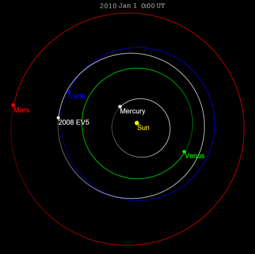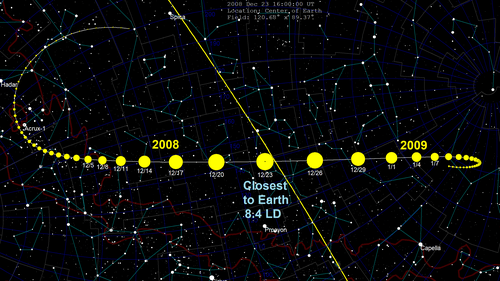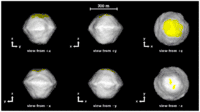(341843) 2008 EV5
(341843) 2008 EV5, provisional designation 2008 EV5, is a sub-kilometer asteroid, classified as a near-Earth object and potentially hazardous asteroid of the Aten group, approximately 400 metres (1,300 feet) in diameter. It was discovered on 4 March 2008, by astronomers of the Mount Lemmon Survey at Mount Lemmon Observatory near Tucson, Arizona, United States.[1]
 Diagram of 2008 EV5's Earth-crossing orbit | |
| Discovery [1] | |
|---|---|
| Discovered by | Mount Lemmon Srvy. |
| Discovery site | Mount Lemon Obs. |
| Discovery date | 4 March 2008 |
| Designations | |
| (341843) 2008 EV5 | |
| 2008 EV5 | |
| NEO · Aten · PHA [1][2] | |
| Orbital characteristics [2] | |
| Epoch 4 September 2017 (JD 2458000.5) | |
| Uncertainty parameter 1 | |
| Observation arc | 2.10 yr (768 days) |
| Aphelion | 1.0383 AU |
| Perihelion | 0.8783 AU |
| 0.9583 AU | |
| Eccentricity | 0.0835 |
| 0.94 yr (343 days) | |
| 213.55° | |
| 1° 3m 2.16s / day | |
| Inclination | 7.4368° |
| 93.390° | |
| 234.81° | |
| Earth MOID | 0.0149 AU (5.8 LD) |
| Physical characteristics | |
| Dimensions | (420 × 410 × 390) m[3] |
Mean diameter | 0.370±0.006 km[4] 0.400±0.014 km[5] 0.400±0.034 km[6] 0.400±0.050 km[3][6] |
| 3.717±0.008 h[7] 3.725 h[8] 3.7255±0.002 h[9] 7.2 h[10] 10.200±0.002 h[8] | |
| 0.104±0.312[6] 0.12±0.04[3] 0.13±0.05[4] 0.137±0.013[6] 0.1373±0.0129[5] | |
| X [11] · C [12] · S (assumed)[8] | |
| 19.7[5][6] · 19.91[8] · 20.0[2] · 20.0±0.4[4] | |
Origin and orbital history
2008 EV5 started its existence as part of a much larger body in the asteroid belt, with a likely diameter greater than 100 kilometers.[13] 2008 EV5's immediate history likely started when its parent body experienced a large cratering event or, more likely, a catastrophic disruption event that resulted in a highly fractured, shattered, or reaccumulated object (rubble pile). As a result, 2008 EV5 may have been produced as a reassembly of ejected fragments. The location of what is now 2008 EV5 within this parent body is unknown.[14]
Given the available modeling work and data, the most plausible source family candidates for 2008 EV5 are Eulalia, New Polana, and Erigone. This assumes that 2008 EV5's true albedo is considerably lower than 10%. If it does have a high albedo, a plausible source would be a population of high-albedo C-type asteroids in the inner asteroid belt. Second tier candidate families for the high-albedo case are Baptistina and Pallas.[14]
From here, the newly liberated 2008 EV5 began to change via the forces referred to as the Yarkovsky and YORP effects. The Yarkovsky effect describes a small force that affects orbital motion. It is caused by sunlight; when objects heat up in the Sun, they reradiate the energy away as heat, which in turn creates a tiny thrust. This recoil acceleration is much weaker than solar and planetary gravitational forces, but it can produce substantial orbital changes over timescales ranging from many millions to billions of years. The same physical phenomenon also creates a thermal torque that probably caused 2008 EV5 to take on a top-like appearance.[3][14][15]
Dynamical models indicate that 2008 EV5 migrated inward across the inner asteroid belt over long timescales (i.e. the order of ~0.01–1 Gyr) until it reached a planetary gravitational resonance that drove it into the near-Earth asteroid (NEA) population over a timescale of the order of ~1 Myr. From there, gravitational interactions with both the planets and resonances allowed it to reach its current orbit within a few Myr to a few tens of Myr.[14]
2008 close approach
On 23 December 2008, 2008 EV5 made a close approach to Earth at a distance of 8.4 lunar distances (0.022 AU, 3.2 million km), its closest until 2169.[3] Its brightness peaked on 26 December about 13.2 magnitude.

Physical characteristics

2008 EV5 is an oblate spheroid (also described as "muffin-shaped"[16]) 400 m (1,300 ft) in diameter. It rotates very slowly in a retrograde direction. There is a 150 m (490 ft) diameter concave feature, possibly an impact crater, or a relic feature from a previous episode of rapid rotation that caused the asteroid's shape to reconfigure.[3]
Visible and near-infrared spectroscopy show that 2008 EV5's composition is similar to that of carbonaceous chondrite meteorites.[12]
Sample return mission
2008 EV5 was the preliminary baseline target of NASA's proposed sample-return Asteroid Redirect Mission. Besides 2008 EV5, several other asteroids, including Itokawa and Bennu, were considered for this mission,[17][18] before its cancellation in 2017.
References
- "341843 (2008 EV5)". Minor Planet Center. Retrieved 17 January 2018.
- "JPL Small-Body Database Browser: 341843 (2008 EV5)" (2010-04-11 last obs.). Jet Propulsion Laboratory. Retrieved 17 January 2018.
- Busch, Michael W.; Ostro, Steven J.; Benner, Lance A. M.; Brozovic, Marina; Giorgini, Jon D.; Jao, Joseph S.; et al. (April 2011). "Radar observations and the shape of near-Earth ASTEROID 2008 EV5" (PDF). Icarus. 212 (2): 649–660. arXiv:1101.3794. Bibcode:2011Icar..212..649B. doi:10.1016/j.icarus.2011.01.013. Retrieved 17 January 2018.
- Alí-Lagoa, V.; Lionni, L.; Delbo, M.; Gundlach, B.; Blum, J.; Licandro, J. (January 2014). "Thermophysical properties of near-Earth asteroid (341843) 2008 EV5 from WISE data". Astronomy and Astrophysics. 561: 8. arXiv:1310.6715. Bibcode:2014A&A...561A..45A. doi:10.1051/0004-6361/201322215.
- Mainzer, A.; Grav, T.; Masiero, J.; Hand, E.; Bauer, J.; Tholen, D.; et al. (November 2011). "NEOWISE Studies of Spectrophotometrically Classified Asteroids: Preliminary Results". The Astrophysical Journal. 741 (2): 25. arXiv:1109.6407. Bibcode:2011ApJ...741...90M. doi:10.1088/0004-637X/741/2/90.
- Mainzer, A.; Grav, T.; Bauer, J.; Masiero, J.; McMillan, R. S.; Cutri, R. M.; et al. (December 2011). "NEOWISE Observations of Near-Earth Objects: Preliminary Results". The Astrophysical Journal. 743 (2): 17. arXiv:1109.6400. Bibcode:2011ApJ...743..156M. doi:10.1088/0004-637X/743/2/156.
- Skiff, Brian A.; Bowell, Edward; Koehn, Bruce W.; Sanborn, Jason J.; McLelland, Kyle P.; Warner, Brian D. (July 2012). "Lowell Observatory Near-Earth Asteroid Photometric Survey (NEAPS) - 2008 May through 2008 December". The Minor Planet Bulletin. 39 (3): 111–130. Bibcode:2012MPBu...39..111S. ISSN 1052-8091.
- "LCDB Data for (341843)". Asteroid Lightcurve Database (LCDB). Retrieved 17 January 2018.
- Galad, Adrian; Vilagi, Jozef; Kornos, Leonard; Gajdos, Stefan (July 2009). "Relative Photometry of Nine Asteroids from Modra". The Minor Planet Bulletin. 36 (3): 116–118. Bibcode:2009MPBu...36..116G. ISSN 1052-8091.
- Behrend, Raoul. "Asteroids and comets rotation curves – (341843)". Geneva Observatory. Retrieved 17 January 2018.
- Ye, Q.-z. (February 2011). "BVRI Photometry of 53 Unusual Asteroids". The Astronomical Journal. 141 (2): 32. arXiv:1011.0133. Bibcode:2011AJ....141...32Y. doi:10.1088/0004-6256/141/2/32.
- Reddy, Vishnu; Le Corre, Lucille; Hicks, Michael; Lawrence, Kenneth; Buratti, Bonnie J.; Abell, Paul A.; et al. (November 2012). "Composition of near-Earth Asteroid 2008 EV5: Potential target for robotic and human exploration". Icarus. 221 (2): 678–681. arXiv:1209.1207. Bibcode:2012Icar..221..678R. doi:10.1016/j.icarus.2012.08.035.
- Morbidelli, Alessandro; Bottke, William F.; Nesvorný, David; Levison, Harold F. (December 2009). "Asteroids were born big". Icarus. 204 (2): 558–573. arXiv:0907.2512. Bibcode:2009Icar..204..558M. doi:10.1016/j.icarus.2009.07.011.
- Mazanek, Daniel; Reeves, David. "Asteroid Redirect Mission (ARM) Formulation Assessment and Support Team (FAST) Final Report" (PDF). NASA Official. National Aeronautics and Space Administration. Retrieved 20 February 2016.

- Walsh, Kevin J.; Richardson, Derek C.; Michel, Patrick (July 2008). "Rotational breakup as the origin of small binary asteroids". Nature. 454 (7201): 188–191. Bibcode:2008Natur.454..188W. doi:10.1038/nature07078. PMID 18615078.
- Wall, Mike (26 March 2015). "NASA wants to pluck a boulder from an asteroid. But which asteroid?". AP News. Retrieved 24 December 2018.
- Steitz, David E. (25 March 2015). "RELEASE 15-050 - NASA Announces Next Steps on Journey to Mars: Progress on Asteroid Initiative". NASA. Retrieved 26 March 2015.
- Borenstein, Seth (25 March 2015). "NASA details plans to pluck rock off asteroid, explore it". AP News. Retrieved 26 March 2015.
External links
- Asteroid Lightcurve Database (LCDB), query form (info)
- Asteroids and comets rotation curves, CdR – Observatoire de Genève, Raoul
- Discovery Circumstances: Numbered Minor Planets (340001)-(345000) (IAU Minor Planet Center)
- (341843) 2008 EV5 at the JPL Small-Body Database